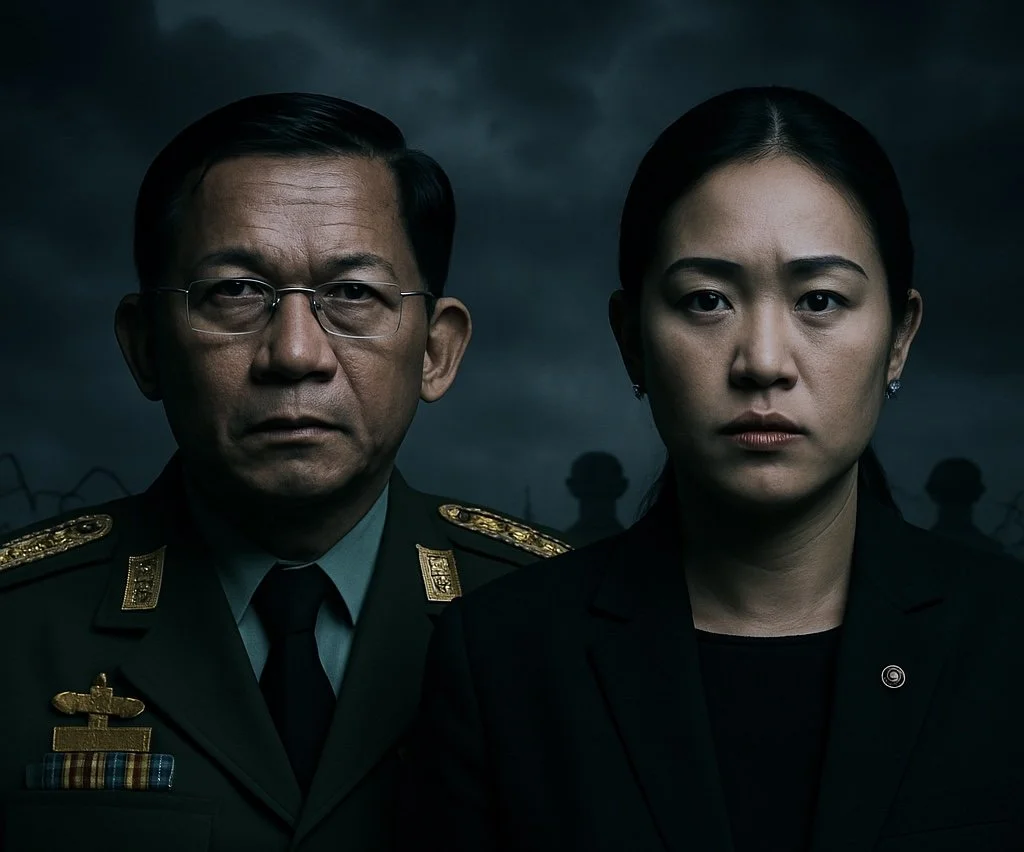A Cautionary Embrace: Why Thailand Must Be Wary of Burma’s Military Leader—and Why the U.S. Should Pay Attention
The recent visit of Burmese Senior General Min Aung Hlaing to Thailand, marked by his high-level meeting with Thai Prime Minister Paetongtarn Shinawatra, has sparked international interest and scrutiny. On the surface, it may seem like a diplomatic exchange between neighbors—but beneath the photo ops and polite rhetoric lies a deeper concern: Min Aung Hlaing’s ambitions, reputation, and track record pose a real risk to Thailand’s stability, global standing, and moral leadership in the region.
This is not a critique of Thailand’s diplomacy. On the contrary—Thailand has long played a vital role as a humanitarian buffer and regional influencer, particularly in Southeast Asia. The concern lies in the character and intentions of the Burmese general, and why the United States and its allies should encourage Thailand to exercise extreme caution in any alliance with Burma’s military regime.
Who Is Min Aung Hlaing—and Why Does It Matter?
General Min Aung Hlaing is not a typical political leader. Since seizing power in a military coup in 2021, his junta has been linked to:
The killing of thousands of civilians, many of them children, women, and ethnic minorities.
Systematic airstrikes on villages in the Karen, Kachin, and Chin regions—sometimes near the Thai border.
Mass displacement, with more than 1 million Burmese fleeing into Thailand, India, and beyond.
The imprisonment of over 20,000 political prisoners, including elected officials and journalists.
Crimes against humanity, with war crime allegations under review by the International Criminal Court and UN Special Rapporteurs.
In short, Min Aung Hlaing’s rule is a blueprint for authoritarianism, brutality, and regional destabilization.
Why This Matters for Thailand
Thailand, a long-standing hub of diplomacy, culture, and regional influence, must now ask a vital question: Does an alliance with a rogue military leader align with Thailand’s vision for the future?
Key Risks for Thailand:
Regional instability bleeding across borders
Violence in Burma isn’t contained—it spills into neighboring countries. Refugees crossing into Thailand aren’t just statistics—they are human lives seeking safety from aerial bombings, mass executions, and burned villages. Welcoming the general responsible for those actions may undermine Thailand’s long-standing humanitarian reputation.Thailand’s international reputation is at stake
While diplomacy with neighbors is expected, photo ops with a known war criminal can be misinterpreted as support or legitimization. This could impact Thailand’s global partnerships, including with the United States and the European Union, who continue to impose sanctions on Burma’s military junta.Long-term strategic misalignment
While cooperation may bring short-term military or economic benefits, aligning with a collapsing regime like Min Aung Hlaing’s could drag Thailand into prolonged regional crises—especially as ethnic resistance movements gain strength and call for a federal democratic system in Burma.
A Better Path Forward
Thailand has historically led by example—providing sanctuary, medical care, and cross-border aid to those fleeing violence in Burma. That humanitarian leadership should not be compromised by overt closeness with a regime that has lost legitimacy across the globe.
Instead, Thailand can:
Engage with community-based organizations on the Thai-Burma border to support stability without strengthening the junta.
Act as a neutral mediator for future peace talks that include ethnic groups and the Kawthoolei Government—not just the junta.
Maintain economic and military independence from a regime that is increasingly reliant on weapons, drug trafficking, and coercion for survival.
Why the U.S. Should Be Paying Attention
The United States has a critical role to play—not by pressuring Thailand, but by supporting its efforts to maintain peace and autonomy.
The U.S. should:
Expand border-based humanitarian aid in partnership with Thailand.
Encourage multilateral diplomacy that includes ethnic and civilian representatives—not just the Burmese military.
Support Thailand’s sovereignty and leadership in Southeast Asia by offering alternative partnerships to offset growing pressure from China and Burma.
Conclusion: Be Cautious, Be Strategic
Thailand’s relationship with Burma is complex and unavoidable—but it must also be carefully navigated. Min Aung Hlaing is not a partner for long-term peace, prosperity, or progress. His regime’s brutality is a stain on Southeast Asia’s collective conscience, and aligning with it comes at a cost.
Thailand has a choice—and a powerful opportunity—to help shape the future of the region by staying true to its tradition of peace, dignity, and regional leadership.
For the U.S., the message is clear: Support Thailand, support the people of Burma, and support a vision of Southeast Asia where freedom—not fear—defines the future.
References
PowerMentor White Paper: “The Karen Crisis and the Future of Kawthoolei” (2025)
UN OHCHR Report on Human Rights Violations in Burma (2024)
Thailand’s Role in Regional Refugee Protection – Human Rights Watch (2023)
U.S. Department of State – Burma Sanctions Fact Sheet (2024)
Brookings Institution – Strategic Risks of Authoritarian Alliances in Southeast Asia (2023)
Karen News – On-the-Ground Reports from the Thai-Burma Border (2024)

